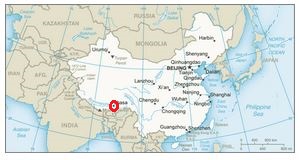 |
| Lhasa, Tibet |
#12,399
For the second time this week the WHO has published an H7N9 update, this time covering 15 cases announced by China's NHFPC on April 15th (see HK CHP Notified Of Another 14 New H7N9 Cases From The Mainland).
This report contained details of the 2nd and 3rd H7N9 cases from Tibet, which are listed as a cluster in today's report. The first case was reported in Tuesday's WHO update.
I've only included some excerpts, follow the link for the full report.
Disease outbreak news
20 April 2017
On 14 April 2017, the National Health and Family Planning Commission of China (NHFPC) notified WHO of 15 additional laboratory-confirmed cases of human infection with avian influenza A(H7N9) virus in mainland China.
Details of the cases
Onset dates ranged from 27 March to 11 April 2017. Of these 15 cases, three were female. The median age is 58 years old (age range among the cases is 39 to 81 years old). The cases were reported from Anhui (1), Beijing (1), Gansu (1), Henan (2), Hunan (1), Shandong (2), Sichuan (3), Tianjin (1), Tibet (2), and Zhejiang (1).
This is the first time a human case with avian influenza A(H7N9) has been reported from Gansu Province and the first time a human case with avian influenza A(H7N9) has been reported in the fifth epidemic wave in Tianjin (previously two cases were reported to WHO in July 2016).
At the time of notification, of the 11 cases with information on the condition of the case, there were two deaths, eight cases were diagnosed as having either pneumonia (1) or severe pneumonia (7), and one case was mild. Twelve cases were reported to have had exposure to poultry or live poultry market and one case had exposure to live poultry sold by street vendors or the environment near the street vendor which might have been contaminated by avian influenza A(H7N9) virus. At the time of notification, there was no information available regarding poultry exposure for two cases.
One cluster was reported and includes:
- A 39-year-old male from Lhasa, Tibet Autonomous Region. He had symptom onset on 28 March 2017 and was admitted to hospital on 1 April 2017. He had severe pneumonia and was still in hospital until 18 April 2017. He worked at a live poultry market and was involved in the slaughter and selling of live poultry.
- A 41-year-old male from Lhasa, Tibet Autonomous Region who was notified to WHO on 8 April 2017. He had symptom onset on 27 March 2017 and was admitted to hospital on 1 April 2017. At the time of the report he had severe pneumonia and he was still in hospital until 18 April 2017. He worked at the same live poultry stall as the 39-year-old male. He was also involved in the slaughter and selling of live poultry.
To date, a total of 1393 laboratory-confirmed human infections with avian influenza A(H7N9) virus have been reported through IHR notification since early 2013.
(SNIP)
WHO risk assessment
The number of human infections with avian influenza A(H7N9) in the fifth epidemic wave (i.e. onset since 1 October 2016) is greater than the numbers of human cases reported in earlier waves.
Human infections with the avian influenza A(H7N9) virus remain unusual. Close observation of the epidemiological situation and further characterization of the most recent human viruses are critical to assess associated risk and to adjust risk management measures in a timely manner.
Most human cases are exposed to avian influenza A(H7N9) virus through contact with infected poultry or contaminated environments, including live poultry markets. Since the virus continues to be detected in animals and environments, and live poultry vending continues, further human cases can be expected. Although small clusters of cases of human infection with avian influenza A(H7N9) virus have been reported including those involving patients in the same ward, current epidemiological and virological evidence suggests that this virus has not acquired the ability of sustained transmission among humans. Therefore the likelihood of further community level spread is considered low.